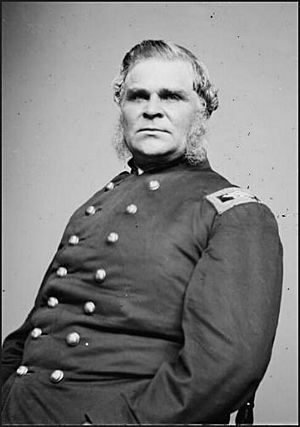Daniel D. Bidwell facts for kids
Quick facts for kids
Daniel Davidson Bidwell
|
|
|---|---|

Daniel Davidson Bidwell
|
|
| Born | August 12, 1819 Buffalo, New York |
| Died | October 19, 1864 (aged 45) Cedar Creek, Virginia |
| Place of burial |
Forest Lawn Cemetery, Buffalo, New York
|
| Allegiance | United States of America Union |
| Service/ |
United States Army Union Army |
| Years of service | 1861–1864 |
| Rank | |
| Battles/wars | American Civil War |
Daniel Davidson Bidwell (born August 12, 1819 – died October 19, 1864) was an important community leader in Buffalo, New York. This was before the American Civil War began. When the war started, he joined the army. He quickly became a colonel leading a group of infantry soldiers. In early 1864, he was promoted to general. He commanded a large group of soldiers called a brigade. He led them until he was badly wounded at the Battle of Cedar Creek, which led to his death.
Early Life
Daniel Bidwell was born in Buffalo, New York, on August 12, 1819. He grew up in the city and went to local schools. Before the war, he was involved in a local volunteer army group. This group was called "D" Company Buffalo City Guard. He became the leader of this group.
Civil War Service
When the Civil War started, Daniel Bidwell joined the 65th New York State Militia. He started as a private, which is the lowest rank. But he was soon promoted to captain. After that, he helped create the 74th New York Militia. On August 1, 1861, Bidwell was made a colonel. He took command of the 49th New York Volunteer Infantry regiment.
As a regimental commander, he fought in the Peninsula Campaign. His regiment was part of the Second Division, VI Corps, in the Army of the Potomac. Bidwell was not at the Battle of South Mountain or the Battle of Antietam. In 1863, his regiment served under General Thomas H. Neill. This was during the campaign that ended with the Battle of Chancellorsville. The 49th New York fought bravely near Fredericksburg, Virginia. They stopped attacks from Confederate General Jubal Early.
Bidwell then fought in the Second Battle of Fredericksburg and the Battle of Salem Church. On May 4, 1863, Bidwell's regiment, with help from artillery, stopped an attack. They fought against the 48th Virginia Infantry. The New Yorkers captured 200 enemy soldiers and their flags. The 49th New York had only 35 soldiers wounded or killed in these fights. Bidwell continued to lead his regiment at the Battle of Gettysburg. There, he served under General Neill on the far right side of the Union Army.
When the Army of the Potomac was reorganized, Bidwell kept his command. He served under General Neill again. They had a new division commander, General George Getty. During the Battle of the Wilderness on May 5, 1864, General Getty was wounded. General Neill then took over as acting division commander. Bidwell then took command of Neill's brigade. This brigade was sent to fight under General Horatio Wright.
On May 6, Bidwell led an attack on the Confederate lines, but it was not successful. Later that day, Confederate General John B. Gordon attacked the Union Army's right side. Bidwell quickly turned his brigade to face the enemy. His stand helped stop Gordon's attack.
Bidwell led his brigade in many major battles. These included the Battle of Spotsylvania, the Battle of Cold Harbor, and the start of the Siege of Petersburg. Colonel Bidwell was promoted to the rank of brigadier general on August 11, 1864.
Fighting in the Shenandoah Valley
After the Siege of Petersburg began, Bidwell served in Washington, D.C. and the Shenandoah Valley. Confederate General Jubal Early tried to attack Washington. But he was delayed long enough for Union troops, including Bidwell's brigade, to arrive. Bidwell’s brigade reached Fort Stevens just as the Confederates were attacking. This fort was a key part of Washington's defenses. Bidwell's brigade moved out and pushed back Early’s soldiers. Bidwell’s command lost about 250 out of 1,000 soldiers in this fight.
Bidwell then served under General Philip H. Sheridan. General Horatio Wright commanded the VI Corps in the new Union Army of the Shenandoah. General Getty had also returned to command the second division. Bidwell led his brigade at the Battle of Opequon and the Battle of Fisher's Hill.
At the Battle of Cedar Creek on October 19, 1864, the Confederate army launched a surprise attack. Many Union soldiers were forced to retreat. By 7:00 AM, the VI Corps was the last group of Union infantry still fighting. When other divisions had to retreat, Getty's second division became the rear guard. Bidwell's brigade held the left side of Getty's division. This line held strong despite constant Confederate attacks and artillery fire. General Bidwell was hit by a Confederate shell and was badly wounded. He died from his wounds. After he was hit, Lieutenant Colonel Winsor B. French took command of Bidwell's brigade.
General Bidwell was buried at the Forest Lawn Cemetery in Buffalo. There is a statue honoring him at Colonial Circle in Buffalo. A special funeral march for piano was written for him by Karl August Goehle.


